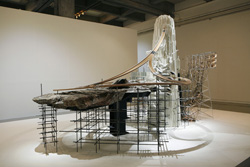

 Lee Bul’s career is in many ways a test case for how an artist whose primary points of reference are equally political and feminist has been able to develop a body of work that leapfrogs most of the expectations of her local situation, instead appealing directly to an international audience that is not likely to be conversant with any of the developments in Korean art from which it might be seen to emerge. Beginning in the mid-1990s with an extensive series of somewhat frightening, hyper-feminized cyborg sculptures, Lee Bul embraced this visually aggressive science-fiction image in order to clarify certain underlying points about how patriarchal systems of desire invariably replicate themselves in the image of that which man seeks to possess. To the artist’s way of thinking, nobody should be surprised, once man has the ability to create lifelike simulations of the human being, when he makes his first companions in the guise of large-breasted females with tiny waists.
Lee Bul’s career is in many ways a test case for how an artist whose primary points of reference are equally political and feminist has been able to develop a body of work that leapfrogs most of the expectations of her local situation, instead appealing directly to an international audience that is not likely to be conversant with any of the developments in Korean art from which it might be seen to emerge. Beginning in the mid-1990s with an extensive series of somewhat frightening, hyper-feminized cyborg sculptures, Lee Bul embraced this visually aggressive science-fiction image in order to clarify certain underlying points about how patriarchal systems of desire invariably replicate themselves in the image of that which man seeks to possess. To the artist’s way of thinking, nobody should be surprised, once man has the ability to create lifelike simulations of the human being, when he makes his first companions in the guise of large-breasted females with tiny waists.
Lee Bul is best known for her extensive investigations into the phenomenon of karaoke, particularly our enduring fascination with modes of technology to reintroduce traditional modes of socialization. Until the advent of recorded music, people frequently sang with or for each other in socal occasions, and in any of Lee Bul’s high-tech variation on this custom, we experience the technology itself as intrinsic to our failure to communicate with one another. In one early example, ‘viewers’ enter a soundproof karaoke booth in which they cannot hear themselves, but anyone outside can. Her most successful adaptation of the karaoke principle was her series Live Forever, which consisted of several futuristic car-pods that the ‘viewer’ entered. Once inside, they had all the filters and enhancers necessary to sound like a professional singer, but there voice never reached anybody outside the pod.
Most recently, Lee Bul has begun exploring the motif of landscape.Typically, she is not developing variations on a single manifestation of landscape so much as she is fusing together multiple landscape references from cinema and art history, to produce a kind of miniature composite world – a planet that seems to reflect both the pinnacle of technological achievement, and an overriding sense of unreality. Like a chunk of the real world broken off and hurtling by itself through space, Lee Bul’s landscapes appear fraught with the dangers and intoxications of a world in which mankind can make any dream a reality, but still can’t come any closer to closing the vast divide that separates the unique spheres of consciousness possessed by two distinct individuals.